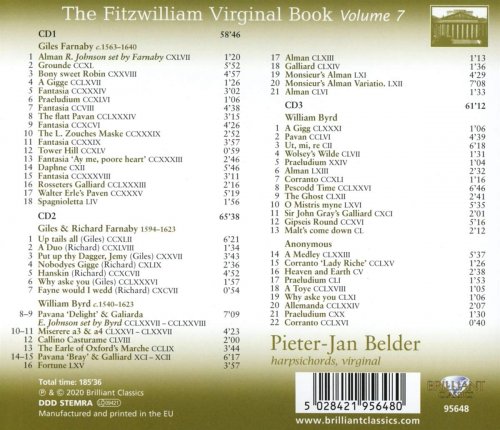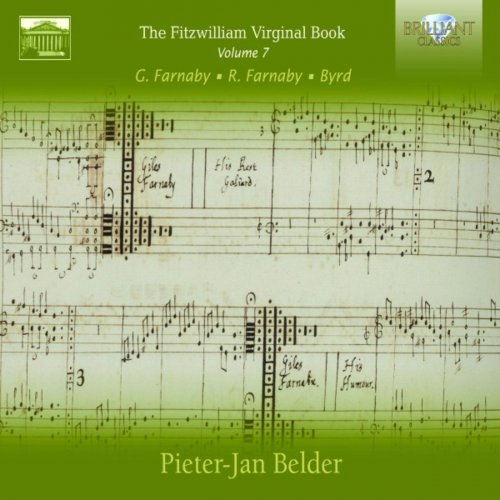
Pieter-Jan Belder - The Fitzwilliam Virginal Book, Vol. 7 (2020)
BAND/ARTIST: Pieter-Jan Belder
- Title: The Fitzwilliam Virginal Book, Vol. 7
- Year Of Release: 2020
- Label: Brilliant Classics
- Genre: Classical
- Quality: FLAC (tracks+booklet)
- Total Time: 185:02 min
- Total Size: 1,2 GB
- WebSite: Album Preview

Tracklist:
01. Alman R. Johnson set by Farnaby CXLVII
02. Grounde CCXL
03. Bony sweet Robin CXXVIII
04. A Gigge CCLXVII
05. Fantasia CCXXXIV
06. Praeludium CCXLVI
07. Fantasia CCVIII
08. The flatt Pavan CCLXXXIV
09. Fantasia CCXCVI
10. The L. Zouches Maske CCXXXIX
11. Fantasia CCXXIX
12. Tower Hill CCXLV
13. Fantasia 'Ay me, poore heart' CCXXXIII
14. Daphne CXII
15. Fantasia CCXXXVIII
16. Rosseters Galliard CCLXXXIII
17. Walter Erle's Paven CCXXXV
18. Spagnioletta LIV
19. Up tails all (Giles) CCXLII
20. A Duo (Richard) CCXLVIII
21. Put up thy Dagger, Jemy (Giles) CXXVII
22. Nobodyes Gigge (Richard) CXLIX
23. Hanskin (Richard) CCXCVII
24. Why aske you (Giles) CCLXXXVI
25. Fayne would I wedd (Richard) CXCVII
26. Pavana 'Delight' E. Johnson set by Byrd CCLXXVII
27. Galiarda CCLXXVIII
28. Miserere a3 CLXXVI
29. Miserere a4 CLXXVII
30. Callino Casturame CLVIII
31. The Earl of Oxford's Marche CCLIX
32. Pavana 'Bray' XCI
33. Galliard XCII
34. Fortune LXV
35. Alman CLXIII
36. Galliard CLXIV
37. Monsieur's Alman LXI
38. Monsieur's Alman Variatio. LXII
39. Alman CLVI
40. A Gigg CLXXXI
41. Pavan CCLVI
42. Ut, mi, re CII
43. Wolsey's Wilde CLVII
44. Praeludium XXIV
45. Alman LXIII
46. Corranto CCXLI
47. Pescodd Time CCLXXVI
48. The Ghost CLXII
49. O Mistris myne LXVI
50. Sir John Gray's Galliard CXCI
51. Gipseis Round CCXVI
52. Malt's come down CL
53. A Medley CLXXIII
54. Corranto Lady Riche CCLXV
55. Heaven and Earth CV
56. Praeludium CLI
57. A Toye CCLXVIII
58. Why aske you CLXI
59. Allemanda CCLXXIV
60. Praeludium CXX
61. Corranto CCLXVI
Now into its seventh volume, Pieter-Jan Belder’s series continues to uncover more works from the Fitzwilliam Virginal Book. In this volume he turns his attention to the works of father and son Giles and Richard Farnaby, William Byrd, and selected anonymous works.
The book and its manuscripts provide us with an insight into Elizabethan and early Jacobean socio-cultural life. After the dissolution of the monasteries in 1536 by Henry VIII followed by Mary Tudor’s blood-soaked crackdown, it was clear that being a Protestant in Tudor England was risky business. Once Queen Elizabeth took the throne in 1558, she established a moderate form of Protestantism and halted the campaign of religious persecution. But the damage was already done, and many composers decided to steer clear of religion altogether and focus their efforts on secular music. (It is thought Farnaby was probably a Puritan sympathiser and Byrd hailed from a protestant background, although he switched to Catholicism later in life.) The
Fitzwilliam Virginal Book is a vital record of such works. Compiled in the late 1700s, the book today resides in a dedicated museum in Cambridge.
The first section of this release surveys Giles Farnaby’s musical output. Bony Sweet Robin is a setting of a popular Renaissance tune and Sir Walter Raleigh once in a letter to Robert Dudley, 1st Earl of Leicester wrote that Dudley was in the Queen’s favour, describing him as ‘her Sweet Robin’. This graceful arrangement is Continental in its nature and similar to the Italian madrigal, with a conjunct and cantabile melody line and through-composed structure. As for Richard Farnaby, the four pieces recorded here are all that survives of his output. Nobodyes jig is his best-known work; a playful dance which requires a skilled performer to successfully execute the fast-paced polyphonic music. The final part features works by Byrd as well as anonymous works including almans, pavans, and keyboard arrangements of lute pieces and popular ballads.
Pieter-Jan Belder is a musicologist as well as a polished performer, and his in-depth study of the Fitzwilliam Virginal Book makes for a highly informed performance practice. In this release, Belder has elected to play a harpsichord by Adlam Burnett after Ruckers and the muselar by Theo de Haas after Ruckers. In their entirety, the seven volumes so far released by Brilliant Classics bring this fascinating book to life and open up an exciting historical soundscape for everyone to discover and enjoy.
The 7th and last installment of one of the most prestigious and ambitious recording projects in Early Music: the complete Fitzwilliam Virginal Book!
The Fitzwilliam Virginal Book is the most famous, extensive and important collection of keyboard music from the English Elizabethan and Jacobean Era. Lodged in the Fitzwilliam Museum in Cambridge it contains more than 300 works for the virginal, by composers such as John, Bull, William Byrd, Thomas Tomkins and many others.
This last volume presents two of the most famous composers of the time: Giles Farnaby and William Byrd, rounded of by a series of anonymous works.
Pieter-Jan Belder plays on copies of Ruckers instruments, built by Titus Crijnen Adlam Burnett and Theo de Haas. The extensive booklet notes are written by the musicologist Jon Baxendale.
Pieter-Jan Belder, one of the world’s most respected and prolific harpsichordists, received rave reviews for his previous issues in this series: “..a captivating portrait..full of rhythmic drive..he displays a keen sense of rhythm…broad and brilliant gestures…one of the most important recording projects of this decade..”(Musicweb-International).
The book and its manuscripts provide us with an insight into Elizabethan and early Jacobean socio-cultural life. After the dissolution of the monasteries in 1536 by Henry VIII followed by Mary Tudor’s blood-soaked crackdown, it was clear that being a Protestant in Tudor England was risky business. Once Queen Elizabeth took the throne in 1558, she established a moderate form of Protestantism and halted the campaign of religious persecution. But the damage was already done, and many composers decided to steer clear of religion altogether and focus their efforts on secular music. (It is thought Farnaby was probably a Puritan sympathiser and Byrd hailed from a protestant background, although he switched to Catholicism later in life.) The
Fitzwilliam Virginal Book is a vital record of such works. Compiled in the late 1700s, the book today resides in a dedicated museum in Cambridge.
The first section of this release surveys Giles Farnaby’s musical output. Bony Sweet Robin is a setting of a popular Renaissance tune and Sir Walter Raleigh once in a letter to Robert Dudley, 1st Earl of Leicester wrote that Dudley was in the Queen’s favour, describing him as ‘her Sweet Robin’. This graceful arrangement is Continental in its nature and similar to the Italian madrigal, with a conjunct and cantabile melody line and through-composed structure. As for Richard Farnaby, the four pieces recorded here are all that survives of his output. Nobodyes jig is his best-known work; a playful dance which requires a skilled performer to successfully execute the fast-paced polyphonic music. The final part features works by Byrd as well as anonymous works including almans, pavans, and keyboard arrangements of lute pieces and popular ballads.
Pieter-Jan Belder is a musicologist as well as a polished performer, and his in-depth study of the Fitzwilliam Virginal Book makes for a highly informed performance practice. In this release, Belder has elected to play a harpsichord by Adlam Burnett after Ruckers and the muselar by Theo de Haas after Ruckers. In their entirety, the seven volumes so far released by Brilliant Classics bring this fascinating book to life and open up an exciting historical soundscape for everyone to discover and enjoy.
The 7th and last installment of one of the most prestigious and ambitious recording projects in Early Music: the complete Fitzwilliam Virginal Book!
The Fitzwilliam Virginal Book is the most famous, extensive and important collection of keyboard music from the English Elizabethan and Jacobean Era. Lodged in the Fitzwilliam Museum in Cambridge it contains more than 300 works for the virginal, by composers such as John, Bull, William Byrd, Thomas Tomkins and many others.
This last volume presents two of the most famous composers of the time: Giles Farnaby and William Byrd, rounded of by a series of anonymous works.
Pieter-Jan Belder plays on copies of Ruckers instruments, built by Titus Crijnen Adlam Burnett and Theo de Haas. The extensive booklet notes are written by the musicologist Jon Baxendale.
Pieter-Jan Belder, one of the world’s most respected and prolific harpsichordists, received rave reviews for his previous issues in this series: “..a captivating portrait..full of rhythmic drive..he displays a keen sense of rhythm…broad and brilliant gestures…one of the most important recording projects of this decade..”(Musicweb-International).
Year 2020 | Classical | FLAC / APE
As a ISRA.CLOUD's PREMIUM member you will have the following benefits:
- Unlimited high speed downloads
- Download directly without waiting time
- Unlimited parallel downloads
- Support for download accelerators
- No advertising
- Resume broken downloads


